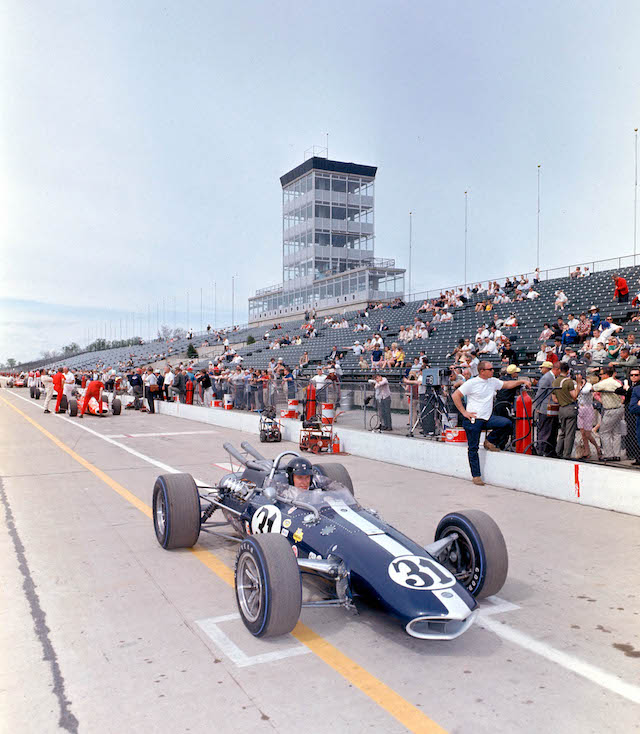THE RACING MACHINES, PART IV.
 Sunday, September 15, 2024 at 09:10AM
Sunday, September 15, 2024 at 09:10AM By Peter M. DeLorenzo
Detroit. They can be testaments to brilliant, visionary thinking, or they can be ideas that never panned out. They can be magnificent beasts that ruled the day, or they can be evil-handling failures that slunk away into motorsports history. But many of the machines that have been raced over the decades brought something significant to the sport, and even more important, etched into our memories a time and a place that will never be forgotten. Anyone who has grown up in and around the sport has developed a list of favorite racing cars from the time they were kids. It usually started along the way with model building kits or slot car sets, but we all developed our favorites, which we've all added to over the years. I am no exception. As a matter of fact, my list is extensive and at times convoluted. But by no means is it meant to be some sort of be-all and end-all. They're just significant to me.
 (Photo by Dave Friedman)
(Photo by Dave Friedman)
There is something special about the 60s NASCAR "Grand National" stock cars (before they became known as "Cup" cars). Brutal, purposeful and just enough of a "stock" look to make it interesting. Here is Junior Johnson in his No. 27 Holly Farms Poultry Ford in the Motor Trend 500 at Riverside International Raceway on January 17, 1965. Johnson finished second to the great Dan Gurney (No. 121 Wood Brothers Augusta Motor Sales Ford) that day. (IMS)
(IMS)
Dan Gurney in the No. 31 All American Racers Eagle/Ford - his very first Eagle Indy car - during practice for the 1966 Indianapolis 500. Gurney's early Eagles - including his magnificent 1967 Eagle F1 machine - were some of the most beautiful open-wheel cars ever built. (Audi)
(Audi)
The mid-engine Auto Union Grand Prix cars were some of the most stunning machines ever created. The Auto Union racing machines - Type A to Type D - were developed and built by a specialist racing department of the company's Horch works in Zwickau, Germany, between 1933 and 1939. The Types A, B and C Auto Union racing machines used from 1934 to 1937 had supercharged V16 engines. The last car in the series - the Type D - was used in 1938 and 1939 and designed to compete under the new 1938 regulations. The Type D had a supercharged 3.0-liter V12 that developed almost 550HP. The machines were very difficult to handle due to extreme power/weight ratios (wheelspin could be induced at over 100 mph), and their extreme oversteer due to the fact that most of the weight was over the rear wheels. The Type D was easiest to drive because of its smaller, lower mass engine that was better positioned toward the machine's center. Between 1935 and 1937, Auto Union Grand Prix cars won 25 races. They were driven by such stars as Ernst von Delius, Tazio Nuvolari, Bernd Rosemeyer (who was particularly adept at handling the difficult machines), Hans Stuck and Achille Varzi. Auto Union's main rivals were the Grand Prix machines from Mercedes-Benz, and their battles produced one of the most glorious eras in Grand Prix racing history. Both factories were awarded huge sums of money from the Hitler regime in order to project the image of German technical superiority. Since the German machines were painted silver, they became known as the Silver Arrows, and they dominated Grand Prix racing until the outbreak of World War II in 1939. (Audi)
(Audi)
 (IMS)
(IMS)
Indianapolis Motor Speedway, May 24, 1981. After winning the Indy 500 the year before (his third win), Johnny Rutherford (No. 1 Chaparral Racing Pennzoil Chaparral 2K/Cosworth) lasted just three laps in the 1981 race. But the Chaparral 2K was the dominant machine at The Speedway in 1979 and 1980. Designed by John Barnard, the 2K started off somewhat conventionally with its bonded and riveted aluminum monocoque chassis. At the front, lower wishbones and top rockers were fitted, while a double wishbone design was utilized in the rear. The magic could be found in its “ground effects” design principles. Two long tunnels ran under the 2K, and as the air passing underneath the car entered the forward section of the tunnels, it created a low pressure zone beneath the car. This had the effect of sucking the car down against the road, increasing the tire grip. The added grip helped the car corner faster and accelerate quicker than its competitors. The Chaparral 2K was powered by a turbocharged, 2.65-liter Cosworth V8 producing in excess of 700HP. This was fed to the rear wheels through a Weismann four-speed gearbox. The narrow engine and gearbox allowed the ground effect tunnels to run all the way to the integrally mounted rear wing. (Getty Images)
(Getty Images)
Riverside International Raceway, October 30, 1966. John Surtees (No. 7 Team Surtees Ltd. Lola T70 Mk.2 Chevrolet) on his way to winning the Can-Am. Lola racing cars were some of the most strikingly beautiful machines ever built. The T70 Can-Am car certainly qualified as such, and the T70 Mk.3B Coupe for distance racing was even more so. It is always a thrill to see these machines run in vintage races. (Getty Images)
(Getty Images)
Laguna Seca, October 12, 1975. Speaking of beautiful Lola racing machines, the Lola T332 Chevrolets that raced in the F5000 series in the U.S. were blistering fast and extremely successful. Here, Mario Andretti (No. 5 Vel's Parnelli Jones Racing Viceroy Lola T332 Chevrolet) and Al Unser (No. 51 Vel's Parnelli Jones Racing Viceroy Lola T332 Chevrolet) make up the front row for the F5000 race at Laguna Seca. Mario and Al ran 1-2 that day.
Editor's Note: You can access previous issues of AE by clicking on "Next 1 Entries" below. - WG





